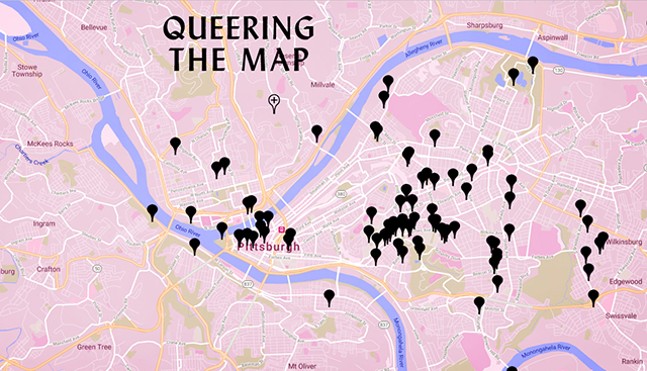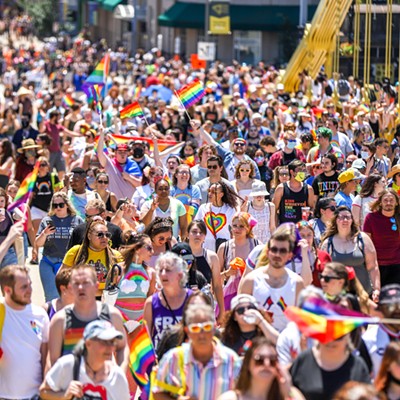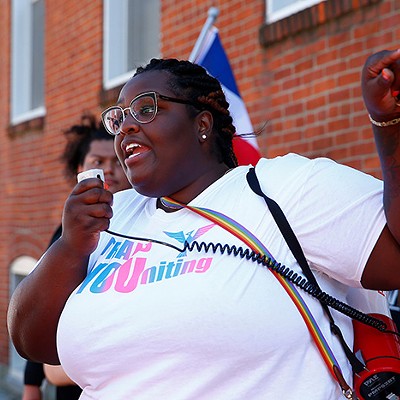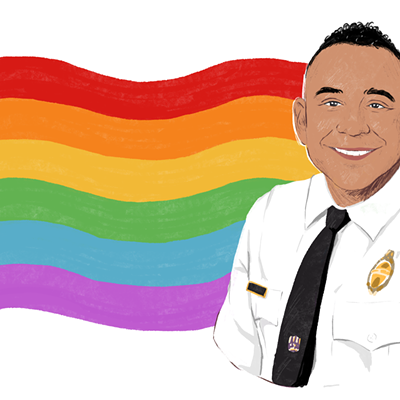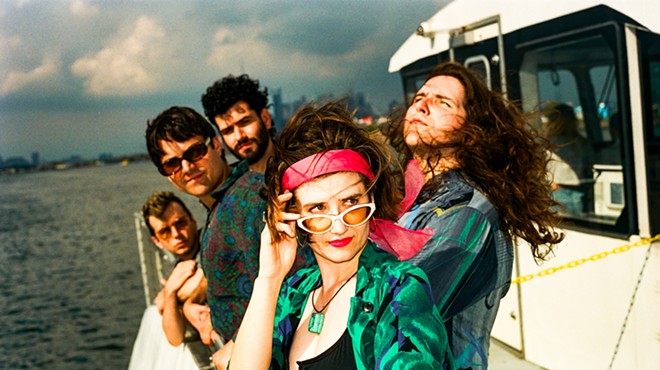I came out to my mom as pansexual here at a Lady Gaga concert surrounded by rainbows and queens.
i told him i might be bi and he sneered. he slowly treated me worse after that.
Lesbian Avengers unfurled a ginormous "Dykes Rule" banner from the Cathedral of Learning on National Coming Out Day, c. 1995
These are a few of the Pittsburgh-centric stories found on Queering the Map, an interactive, online project that allows users to anonymously highlight places where they experienced moments significant to their lives as LGBTQ people. While each pin is different, they all contribute to visualizing the LGBTQ experience around the world.
Launched in May 2017 by Montreal-based college student, multidisciplinary designer, and web developer, Lucas LaRochelle — who identifies as queer/non-binary — Queering the Map has quickly grown from collecting stories in its founder’s native country to being used by LGBTQ people from all over, including in Southwestern Pennsylvania.
LaRochelle says the site has received around 67,000 stories in 23 languages (36,000 are currently live on the map, while over 30,000 are pending approval). They see the site as fulfilling multiple roles by documenting the LGBTQ experience, which they say is “often erased from both the built environment, as well as in institutional archives”; redefining queer spaces beyond places of consumption, like bathhouses, bookstores, and bars; and capturing the full spectrum of LGBTQ life.
“Queer life is as exciting as it is terrible as it is boring,” says LaRochelle, adding that the anonymity of Queering the Map encourages the LGBTQ community “to tell our stories in a way that feels meaningful for us.”
In Pittsburgh specifically, there are stories about coming out, first times, sexual encounters, and relationships, varying in length from one sentence to multiple paragraphs (LaRochelle says there’s no word count limit, but submissions tend to be short). There are also accounts of experiences, either hostile or friendly, at places of worship or schools. Some lament the loss or celebrate the existence of LGBTQ businesses in the city.
LaRochelle believes Queering the Map can also help LGBTQ people, especially ones who are isolated or living in fear, feel less alone, and to “resist the narrative that the only space in which queer people exist are in urban centers.”
This hits close to home for LaRochelle, who recounts the feeling of seeing a pin in the rural Ontario town where they grew up.
“For most of my life … I didn’t know any other openly queer people, and so to see that location, it was an extremely emotional moment,” says LaRochelle. “It was this sort of solidarity, where even though I don’t know that person, I know that they exist and I feel held by their presence.”
While the biggest clusters in the region center around Pittsburgh, dotted throughout are pins in less populated parts of Southwestern Pennsylvania in towns like Greensburg, Sarver, and Ford City.
But the path to giving LGBTQ people a geo-centered voice hasn’t exactly been smooth. In February 2018, Queering the Map went dark after spammers attacked the site with a bot that generated pop-ups and pins in support of President Donald Trump. With the help of what LaRochelle calls the “queer coder” community, the site returned in April with a moderator panel to screen for content that contains hate speech, spam, or unsafe material (such as a person’s phone number or address), as well as better safeguards for users’ privacy and security.
But with the improvements comes the new challenge of moderating stories in an efficient, timely manner. LaRochelle says they need additional funding and support to create a system able to comb through and approve the “enormous backlog” of stories they received over the past four months alone.
LaRochelle says they also weren’t prepared for the amount of emotional labor that comes with managing the site, as many stories detail the trauma or shame many LGBTQ users have experienced.
Even so, they plan on making the site more accessible by improving its mobile interface and translating its description outside of English, which, LaRochelle says, would also “disrupt the narrative that queerness is a Western phenomenon.”
“I very much see my role now as facilitator of the project, and figuring out how to make it sustainable into the future because of the way in which people are responding to it,” says LaRochelle.

